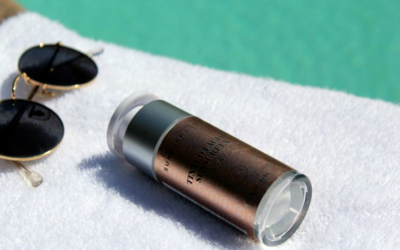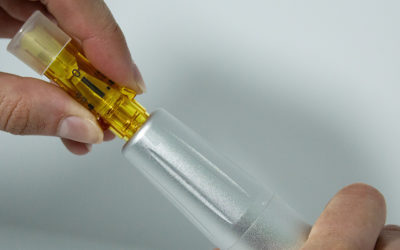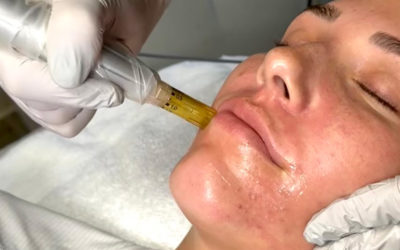Micro Needling for drug delivery
Last updated on September 17th, 2019
One emerging “off label” use for micro needling devices is to facilitate the successful topical delivery of biological and non-biological compounds. In the November/December 2012 issue of THE Aesthetic Guide, Gordon Sasaki, M.D. discussed this very subject in an article about the Dermapen micro needling device. “[Transdermal drug delivery] is an obvious use of the device. Whenever we can generate openings of this nature in the skin we have an opportunity for topicals to penetrate more readily through the channels created,” he said. “Non-biological materials such as cosmeceuticals or pharmaceuticals, or biological materials such as bioactive peptides of PRP [platelet-rich plasma], could be delivered in this way.” Dr. Sasaki practices plastic surgery in Pasadena, Calif. and is a renowned educator and researcher as well.
As Dr. Sasaki stated, this use of microneedling devices is obvious; you make holes in the skin, and whatever you place on the skin is more likely to penetrate. One could either apply the topical to skin and use a microneedling device to drive it into the epidermis, or make holes with microneedling and apply topical afterward. Additionally, use of micro needling devices such as Dermapen for this purpose suggests the topical delivery of compounds not previously deliverable by that method. In the article Dr. Sasaki further stated that for molecules to penetrate the epidermis, they must be lipophilic and no larger than 500 Daltons. This is known as the 500 Dalton rule [Bos JD, Meinardi MM. The 500 Dalton rule for the skin penetration of chemical compounds and drugs. Exp Dermatol. 2000 Jun;9(3):165-9.] and microneedle technology allows the medical community to successfully experiment with larger molecules, opening up the use of a much wider variety of compounds. It is important to remember, however, that some things already delivered topically are formulated with delivery systems not meant to penetrate the skin. Such compounds may cause an adverse reaction.
The technology could also be used to modulate penetration of topicals in different areas of the face. For example, if a compound was being delivered over a larger area but one wished for better penetration in a particular area, a micro needling device could be used toward that end.
If you want to improve penetration of topically-administered drugs or other therapeutic compounds, microneedle technology is the way to go. The principle is simple: The user can either paint the area with a topical and use micro needling to drive the compound into the skin, or use the technology to create a pattern of holes and then apply topical afterward. The window of opportunity for the latter technique is about 10 or 15 minutes after micro needling, according to Pasadena, Calif. based plastic surgeon Gordon Sasaki, M.D., who is an expert and researcher in the field. “[Drug delivery] is an obvious use of the device. Whenever we can generate openings of this nature in the skin we have an opportunity for topicals to penetrate more readily through the channels created,” he said in a recent issue of THE Aesthetic Guide [Nov/Dec 2012, pp. 3-9]. “Non-biological materials such as cosmeceuticals or pharmaceuticals, or biological materials such as bioactive peptides of PRP [platelet-rich plasma], could be delivered in this way.”
One must, of course, take care not to use micro needling with just any compound; the constituents of some topicals are not meant to be introduced past the skin barrier and could cause problems. But the upside is enormous because many compounds previously undeliverable by topical means are now open to experimentation. Who knows where this may lead? Also, users may choose to improve penetration in one area but not another, providing a controlled but more tailored delivery of topicals. The potential for this is exciting, although much work must be done to determine protocols for improved efficacy and safe use.
—-
The technology of micro needling, which has its origins in ancient practices with a modern twist, may be simple but seems to have much potential. It is very possible that dermatology and plastic surgery practices—any physician office offering aesthetic treatments, for that matter—will not be able to succeed without regular use of the technology.
For example, these types of practices regularly use topically delivered biological and non-biological compounds. Micro needling devices can improve or otherwise modulate penetration of topicals. This is an obvious use of the technology, said researcher and practicing plastic surgeon Gordon Sasaki, M.D. (Pasadena, Calif.). “Whenever we can generate openings of this nature in the skin we have an opportunity for topicals to penetrate more readily through the channels created. Non-biological materials such as cosmeceuticals or pharmaceuticals, or biological materials such as bioactive peptides of PRP [platelet-rich plasma], could be delivered in this way.” [THE Aesthetic Guide, Nov/Dec 2012, pp. 3-9]. Not every topical is suitable, of course, but if properly and rigorously studied, the potential for this application of micro needling is powerful. One could harness new compounds whose molecular weight was previously too large for topical delivery as well as improve penetration of existing drugs.
A major and immediate technological beneficiary of this concept is platelet-rich plasma (PRP), which has the virtue of being derived from the patient’s own blood. Injection of PRP is becoming more popular but is painful and less tolerable than delivery in conjunction with a micro needling device. A safe, easy-to-use device such as Dermapen helps doctors
Dermapen is a Class 1 FDA cleared device. Indications of 878.4820 devices are: General Dermabrasion, Scar Revision, Acne Scar Revision, Tattoo Removal. The contents of this website are provided for informational purposes only and is not intended as a substitute for the advice of a physician or other health care professionals.
Find certified Dermapen microneedling professionals
Dermapen® Microneedling Devices are exclusively sold to Medical and Skin Care Professionals. Use the form to the right to get started finding a Certified Dermapen® practitioner in your area.
Enter your location information to find a Dermapen Skin Care Professional.
Want to become a Dermapen Practitioner?
Medical Clinics and Spas can offer their patients the worlds most advanced microneedling treatments with Dermapen
Microneedling Treatments
The Dermapen Microneedling Pen provides an unparalleled response through the segmented delivery of microneedles, creating micro injuries to the epidermis (outer layer of skin) and dermis (the inner layer of skin). As a result, the micro injuries encourage the body’s innate ability to repair itself.
Every Dermapen tip is outfitted with 12 needles and features our patented technologies, which include SureSpace™ and SafLok™. Accordingly, these safety enhancements can be found in every Dermapen needle tip and pen.
Furthermore, by using SureSpace™ and SafLok™ microneedling pen technologies, practitioners can deliver their patients the safest microneedling treatment possible, while getting the best microneedling results for their patients.



